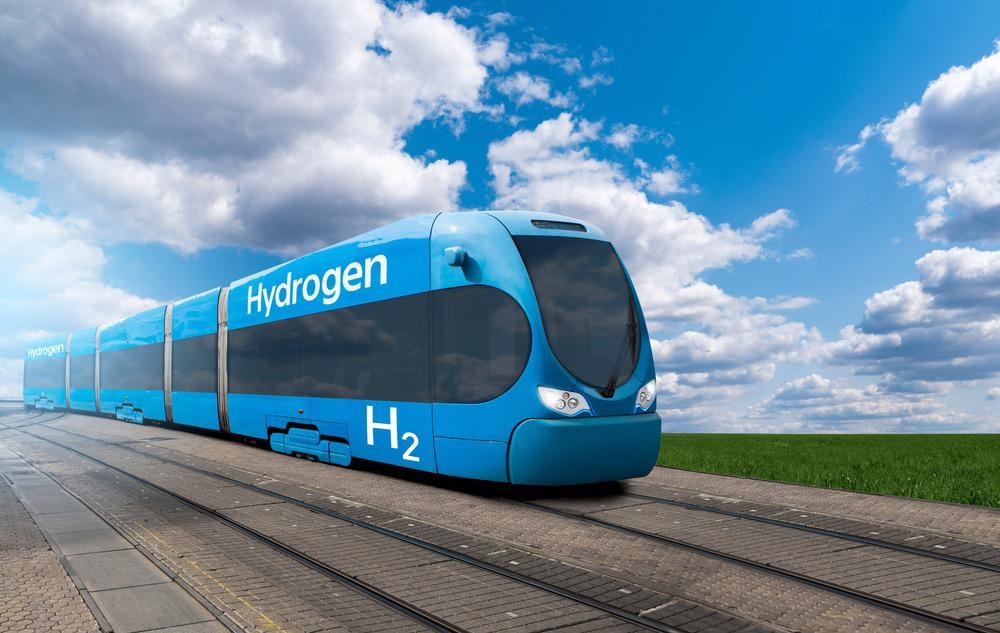With COP26 focusing attention on the UK’s progress towards decarbonizing its industry, commercial sectors, and transportation sectors, there has been renewed interest in the potential of rail to help meet these carbon reduction targets.

Hydrogen trains could be the future of sustainable transport. Image Credit: Scharfsinn/Shutterstock.com
The potential of hydrogen to provide a sustainable, economical source of fuel for mass transportation is widely recognized, and with the UK aiming to remove diesel-only trains from its network by 2040, hydrogen-powered trains offer an appealing alternative to traditional electric vehicles.
Hydrogen fuel cell technology offers more efficient and powerful efficient energy output than fossil fuels. The use of hydrogen fuel cells also removes the need for electrification of lines – an expensive, time-consuming process. This means that hydrogen-powered trains could directly replace diesel trains on virtually any existing route.
Network Rail—the owner and manager of the majority of the UK’s rail infrastructure—announced in May this year that it was working towards the development of a hydrogen fuel cell for use on the UK’s rail network with a view to showcasing this at COP26.
The HydroFLEX is the result of a collaboration between Network Rail, rolling stock owner, and asset manager Porterbrook, and the Birmingham Centre for Railway Research and Education (BCRRE).
The HydroFLEX train was developed from a Class 319 train – a class first built in 1987.
The train’s hydrogen-powered fuel cell unit is able to convert a mixture of hydrogen and oxygen to generate electricity of up to 100kW. The only by-product of this process is water. As a bi-mode electric hydrogen train, HydroFLEX is also fitted with two lithium-ion battery packs for electrical energy storage. The train’s fuel cell unit is powered by hydrogen from tanks, while oxygen is sourced from ambient air.
Delegates at COP26 were invited to preview and explore the HydroFLEX, but the train was unable to demonstrate its operation via hydrogen power due to health and safety considerations.
Hydrogen-powered trains have already been developed and implemented in a number of countries, The Alstom Coradia iLint™ was the world’s first hydrogen fuel cell passenger train – a quiet, entirely emission-free train that only emits water vapor and condensation.
The Coradia iLint™ entered regular passenger service in Germany in 2018 and in Austria in 2020. Earlier this year, the iLint™ made its debut journey on the Railway Research Institute’s test track in Żmigród, close to Wrocław in Poland, showcasing the potential to also decarbonize Poland’s rail network. 2021 also saw the iLint™ make its first journeys in France and Sweden.
Unfortunately, these existing custom-developed hydrogen-powered trains are considered to be too tall to be able to traverse the UK’s existing rail systems – particularly tunnels – prompting the decision to implement hydrogen fuel technology in existing rolling stock and to use standard train classes.
Most recently, however, Alstom has been reported to have signed a memorandum of understanding with a UK-based Eversholt Rail with a view to putting a fleet of hydrogen trains into passenger service based on Alstom’s existing Aventra platform.
HydroFLEX: The UK's first Hydrogen train
Video Credit: University of Birmingham/Youtube.com
This move would represent the first hydrogen fleet in the UK that is hydrogen-powered from the start of its service life, offering further options for the necessarily rapid decarbonization of the UK’s transport infrastructure. Final contracts are expected to be signed in early 2022.
Investments in rail travel are being prioritized throughout the world, with sustainable rail travel expected to form a central part of this strategy.
The US has introduced a $2 trillion USD infrastructure plan with a heavy focus on rail, while the €100 billion Horizon Europe initiative has seen significant research and innovation funding directed to the rail industry. China aims to spend $205 billion USD on new infrastructure projects, with 59% of these funds ringfenced for rail and metro systems.
The cost of hydrogen production remains one of the most notable barriers to its widespread adoption as a fuel source, with much of this cost the result of the high electrical use of green hydrogen production methods.
A recent report by Morgan Stanley Research suggested that increasing availability of renewable energy sources could lead to a sharp decline in energy costs over the coming years, therefore leading to a decline in the cost of hydrogen production – as much as a 70% reduction by 2030.
With ongoing investment and continued technological advancement, there is considerable potential for hydrogen-powered trains to present a model for sustainable, efficient mass transportation that could inform and inspire other sectors towards a more sustainable future.
Disclaimer: The views expressed here are those of the author expressed in their private capacity and do not necessarily represent the views of AZoM.com Limited T/A AZoNetwork the owner and operator of this website. This disclaimer forms part of the Terms and conditions of use of this website.